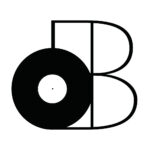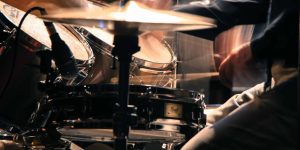If you’re looking for the best perfect balance of precision and simplicity, you’ll most likely want to start learning how to record drums with 4 microphones. If you’ve read my other articles on recording drums at home, you know that it’s possible to record professional sounding drums with just ONE microphone! Recording with 4 microphones has its challenges, but it’ll be completely worth it.
If you’re planning to learn how to record drums with 4 microphones, you’ll need to equip yourself with the appropriate microphones/audio interfaces. Actually, you’ll notice that typical 2-in/2-out audio interfaces won’t do the trick anymore! We’ll be needing at least 4 inputs and that could get slightly expensive… That’s why you’ll want to read about my budget friendly for both microphones and interfaces. However, please understand that EVERY product mentioned in this article is either better or equivalent to some of the more expensive gear out there. Before getting into that though, we’ll be looking at some popular microphone configurations. Let’s get to work!
- Recording drums with 4 microphones using kick, snare and overhead microphone placement
- Recording drums with 4 microphones using kick, snare and “Recorder Man” microphone placement
- Recording drums with 4 microphones using the Samson C02
- Recording drums with 4 microphones using the Sennheiser e 602-II
- Recording drums with 4 microphones using the AKG P5 S
- Recording drums with 4 microphones using the Behringer XENYX 1202FX
- Recording drums with 4 microphones using the Zoom H4n Pro
- How I personally record drums with 4 microphones
Recording drums with 4 microphones using kick, snare and overhead microphone placement
It’s probably one of the most common microphone configurations for record drums with 4 microphones, but it’s also one of the most effective. By placing your pair of stereo overheads above the kit, you’ve already got 99% of the work done.
The additional kick drum/snare drum microphones add more definition.
However, the addition of kick drum microphones is essential in my opinion. Even if your overheads have an extended frequency response (20 – 20,000 Hz), it’ll still be difficult to get your kick drum to cut through the mix.
Low-frequencies are difficult to work with, so it’s recommended to use specialized microphones.
The snare drum is less of an issue, but having its own track allows for much more leeway when it comes to the mixing stage.
So, you’ll want to start by mastering your overhead microphone placement. I talk more about this in my article entitled “how to record drums with 2 microphones”, but you’ve basically got the choice between using X/Y configuration and ORTF/NOS.
I recommend using condenser microphones for the overheads, but the kick/snare drum microphones should be dynamic (moving-coil) microphones. That’s because we’ll be miking these instruments in close proximity (recommendations coming up).
Recording drums with 4 microphones using kick, snare and “Recorder Man” microphone placement
In recent times, sound engineers have been starting to use the “Recorder Man” microphone configuration for overheads. One of the main problems with using more than one microphone involves phase cancellation (or phasing).
Essentially, microphones placed apart from one another will experience some form of audible latency.
The “Recorder Man” technique was created to combat the speed of sound (literally). By placing the overhead microphones apart from one another, but equidistant (same distance from the sound source), we can actually eliminate phasing!
Here’s how you set that up:
- Place one microphone approximately 40-inches above the snare (pointing towards it)
- Place the other microphone approximately 40-inches away from the snare drum, but this time it’s over the drummer’s right shoulder (still pointing towards the snare)
It’s pretty simple in theory, but you’ll need to get your measurements perfect to avoid phasing.
The rest is the same as the previous method. The only variation with the “Recorder Man” technique involves the overheads and not the kick/snare drum microphones.
Recording drums with 4 microphones using the Samson C02
I’ve been researching the pair of Samson C02 a lot lately and I still haven’t found anything as affordable/high-quality. I’m not recommending any other overhead microphones for the moment because these ones are perfect for the job.
You’ll be glad to have the pair of Samson C02 in your collection because they’re versatile.
As small-diaphragm condenser microphones, they’re REALLY sensitive compared to dynamic microphones. Since we’ll be miking from a distance, it’s pretty much essential or you’ll definitely lose some definition for things like ghost-notes.
Here are some of the highlights of the C02 for drums in particular:
- 134 dB SPL
- 40 – 20,000 Hz frequency response
- Matched stereo pair
- Cardioid pickup pattern
In other words, they’re sturdy enough to handle the amplitude of your drum kit.
The frequency response isn’t optimized for sub-frequencies though, but that won’t matter since we’ll be adding the additional kick drum microphone. You can read my product review if you want to find out more about the pair of Samson C02.
Recording drums with 4 microphones using the Sennheiser e 602-II
When I found out about the Sennheiser e 602-II, I was seriously impressed! For the longest the time, the Shure BETA 52A has been the industry standard for recording kick drums, but I believe it’s Sennheiser’s turn to shine!
The e 602-II is more affordable than the BETA 52A and dare I say BETTER.
One of the main things about this German-made kick drum microphone was its modern design. It’s new to the scene which is probably why it isn’t as popular as the Shure BETA 52A, but I believe that’ll be changing. Lots of reviews I’ve read praise the Sennheiser e 602-II.
Here are a few things it does better than the BETA 52A:
- Higher output impedance (350 ohms)
- Half the weight (318 g)
- Extended frequency response (20 – 16,000 Hz)
However, many of its users report that it sounds very close to the BETA 52A.
I personally think it’s better because of its higher output voltage, it’s lower price and higher quality (it is made in Germany after all). I’ve compared the Sennheiser e 602-II with the Shure BETA 52A extensively in this product review.
Recording drums with 4 microphones using the AKG P5 S
One of my favourite dynamic microphones for just about everything is the AKG P5 S. It’s basically what I use instead of the Shure SM57 because it’s actually better in many ways.
The AKG P5 S is another one of those underrated and underpriced microphones.
It seems like AKG created this microphone for vocalists primarily, but it can be used on many other instruments including snare drum! Like the Shure BETA 52A, I believe that the Shure SM57 should give the AKG P5 S its rightful place in the spotlight.
Here are some things it does better than the SM57:
- Extended frequency response (40 – 20,000 Hz)
- Supercardioid polar pattern (more isolation)
- Higher output impedance (580 ohms)
Once again, the AKG P5 S is another modern microphone that could provide some significant advantages over the classic Shure SM57.
One of the main things to consider is the extended frequency response which makes this microphone much more versatile. I highly recommend reading my product review if you’re interested in finding out more about the AKG P5 S.
Recording drums with 4 microphones using the Behringer XENYX 1202FX
Now, the last thing you’ll want to consider if you’re planning to learn how to record drums with 4 microphones is inputs. Most audio interfaces that exceed 2 inputs are generally much more expensive and don’t really add anything new to the table.
As an alternative, I recommend checking out the Behringer XENYX 1202FX portable mixer/audio interface.
Before looking into this project, I never knew that mixers could be used as audio interfaces. That being said, you’ll be amazed at what the XENYX 1202FX has to offer for such an affordable price tag (it’s less expensive than 90% of the audio interfaces out there).
Here are some features you won’t find on typical audio interfaces:
- Onboard 3-band EQ
- Onboard one-knob compressor
- Onboard multi-effects processor
- 4 XLR/12 line inputs
The Behringer XENYX 1202FX is also an excellent option for live gigs.
I think it’s the most affordable way to start recording drums with 4 microphones and provides some very useful features. If you want to find out more, you can read my product review! However, we’ve got one more option to look at…
Recording drums with 4 microphones using the Zoom H4n Pro
If you want to learn how to record drums with 4 microphones, then you’ll want to hear about this. The Zoom H4n Pro might not be for everybody, but for some it’ll become an indispensable tool.
I actually sold mine recently, but that was before I purchased an acoustic drum kit.
If you aren’t familiar with the device, I highly recommend reading my product review. I’ll simply be focusing on how the Zoom H4n Pro can teach us how to record drums with 4 microphones, so I might skip over some important features.
Here’s how this ONE device can do it all:
- Integrated X/Y configured condenser microphones (for overheads)
- Two additional XLR inputs (for kick drum and snare drum microphones)
- USB connectivity to serve as an audio interface
- Onboard multi-effects processing
- Onboard multi-track recording
As long as you’ve got your other microphones, you can easily use the Zoom H4n Pro on its own to record your entire drum kit.
It’s the swiss-army knife of microphones/audio interfaces, so it’s perfect if you’re just getting started with recording drums at home. Considering how affordable it is to begin with, you’ll be saving lots of time and money right off the bat. Read more about it here.
How I personally record drums at home using 4 microphones
For the moment, I’m still using a combination of microphones and sample libraries. For example, I’ll record drums using 2 microphones and I’ll layer an additional kick drums and/or snare drum from my sample library if necessary.
Technically speaking, it’s exactly like using 4 microphones.
I didn’t want to get too much into this method since I assumed you were interested in learning how to record drums with 4 microphones using ACTUAL microphones. However, I encourage you to consider working this way if the project seems too demanding for you at first.
I personally started recording drums with 2 microphones and found it much simpler.
It’s also an advantage because you can layer different kicks/snares to expand your tonal possibilities. It’s much less expensive to own one of these sample libraries than it is to buy 20 different drum kits!
On that note, I’ll be leaving you with the usual shopping list along with some additional items that you’ll need to complete your recording system for drums. I still encourage you to do your own research though and make comparisons for yourself.
Samson C02 Small-Diaphragm Condenser Microphone (pair):
Sennheiser e 602-II Dynamic Kick Drum Microphone:
AKG P5 S Dynamic Supercardioid Vocal Microphone:
Behringer XENYX 1202FX USB Audio Interface/Mixer:
Zoom H4n Pro Portable Multi-Track Recorder:
Once we pass the 2 microphone threshold, recording drums at home becomes slightly more complicated. However, I hope this guide has provided some clarity so that you can decide for yourself if it’s worth it. I still recommend starting with two (or even one) microphone and I would consider experimenting with samples (especially the ones included with your DAW). If you’re really serious about recording drums with 4 microphones though, I personally think the Zoom H4n Pro is the most interesting option. It’s even more useful if you travel a lot and play live. Feel free to reach out if you need any assistance, I’d be more than happy to provide additional tips/tricks. Thanks!
Sources:
https://www.soundpure.com/a/expert-advice/recording/4-mic-recorderman-setup-for-drum-kits/
http://jonstinson.com/the-recorder-man-drum-miking-technique/
http://www.samsontech.com/samson/products/microphones/condenser-microphones/c02/
https://en-ca.sennheiser.com/e-602-ii
https://www.akg.com/Microphones/Dynamic%20Microphones/P5S.html








4 thoughts on “How To Record Drums With 4 Microphones”
Thank you for making us read this beautiful article on how to record drums with 4 microphones . I enjoyed reading this article. So, anyone searching for the same topic may find their shelter over here. This is a great article and you are spot on with your points about it.
I really appreciate the kind words! I’m also glad you enjoyed the read, all the best.
– Stefan
This is really interesting, recording drums with 4 microphones, that sounds great. I’m a good drummer but not a freak of it and I don’t know much about recording but after reading through this, I think I’ll visit your previous articles and read through for more information. Thanks for sharing this here, I’ll forward it to some of my friends too.
Hey BeyondCol,
It’s always a great idea to record your drums, even if you’re not a professional. It’s one of the best ways to monitor your progress and to hear your weaknesses. However, I recommend checking out my article on how to record drums with 2 microphones instead.
It’s easier to start out that way and it’s obviously simpler/more cost-effective.
I’m also planning to release some videos on my YouTube channel and am also working on a home recording course. If you’re interested in either of those two things, consider subscribing to my mailing list for the latest updates.
Thanks for dropping by, I’m here if you have any questions!
– Stefan